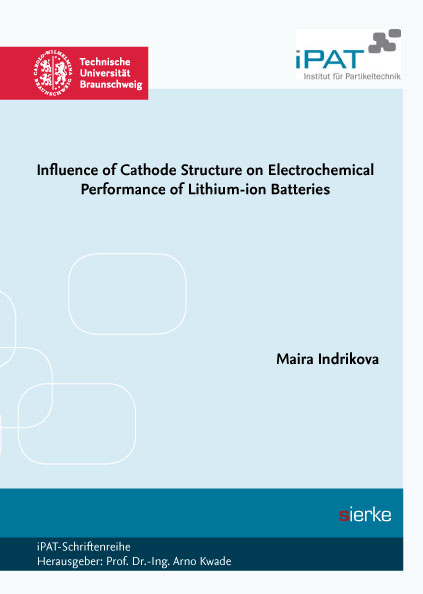
Influence of Cathode Structure on Electrochemical Performance of Lithium-ion Batteries
Seiten
2017
sierke VERLAG - Sierke WWS GmbH
978-3-86844-890-0 (ISBN)
sierke VERLAG - Sierke WWS GmbH
978-3-86844-890-0 (ISBN)
Every single step in the electrode manufacturing process has a vital impact on battery performance. The addition of conductive additives, slurry processing, film casting, and calendering are known to affect the electrode structure that in turn defines the electrochemical properties of a battery. A deep, fundamental understanding of the cathode structure enables a distinct improvement of cell characteristics.
In this work, the electrode structure is studied with respect to the distribution of the binder and the conductive additives. The importance of the network of pure conductive additives is presented with the help of novel model experiments, in which the active material in the electrode is substituted with insulating ceramic particles of various diameters. Moreover, the distribution of polyvinylidene difluoride binder is illustrated. The results of these systematic experiments show that electrical conductivity strongly depends on the porosity, the size of ceramic particles, and the amount and distribution of conductive additives.
Furthermore, LiNi1/3Co1/3Mn1/3O2 cathode electrodes are analyzed regarding physicochemical properties. In these experiments, the combination of cathode thickness (loading) and porosity are examined, aiming at an essential understanding of how the electrochemical performance is modified by changing these parameters. In addition, the combination of processing parameters is studied in greater detail. LiNi1/3Co1/3Mn1/3O2 cathode composites with conductive additive variations are fabricated using a reference and an intensive mixing process, and are subsequently calendered to different porosities. Findings show that the calendering process can have a positive or negative impact on battery performance, and it highly depends on the chosen processing route. Similarly, graphite addition can have different impacts on the resulting electrochemical properties. The results are explained with the help of physical concepts based on conductive pathways, which are established during the electrode processing.
Electrode processing is clearly one of the major factors that need to be understood in order to further improve the long-term cycling stability, rate capability, and energy density of batteries.
In this work, the electrode structure is studied with respect to the distribution of the binder and the conductive additives. The importance of the network of pure conductive additives is presented with the help of novel model experiments, in which the active material in the electrode is substituted with insulating ceramic particles of various diameters. Moreover, the distribution of polyvinylidene difluoride binder is illustrated. The results of these systematic experiments show that electrical conductivity strongly depends on the porosity, the size of ceramic particles, and the amount and distribution of conductive additives.
Furthermore, LiNi1/3Co1/3Mn1/3O2 cathode electrodes are analyzed regarding physicochemical properties. In these experiments, the combination of cathode thickness (loading) and porosity are examined, aiming at an essential understanding of how the electrochemical performance is modified by changing these parameters. In addition, the combination of processing parameters is studied in greater detail. LiNi1/3Co1/3Mn1/3O2 cathode composites with conductive additive variations are fabricated using a reference and an intensive mixing process, and are subsequently calendered to different porosities. Findings show that the calendering process can have a positive or negative impact on battery performance, and it highly depends on the chosen processing route. Similarly, graphite addition can have different impacts on the resulting electrochemical properties. The results are explained with the help of physical concepts based on conductive pathways, which are established during the electrode processing.
Electrode processing is clearly one of the major factors that need to be understood in order to further improve the long-term cycling stability, rate capability, and energy density of batteries.
| Erscheinungsdatum | 09.03.2017 |
|---|---|
| Verlagsort | Göttingen |
| Sprache | englisch |
| Maße | 148 x 210 mm |
| Gewicht | 250 g |
| Einbandart | geklebt |
| Themenwelt | Naturwissenschaften ► Chemie ► Physikalische Chemie |
| Technik ► Elektrotechnik / Energietechnik | |
| Schlagworte | binder distribution • calendering • Capacity • Condructive additives • electrical conductivity • electrode manufacturing • Film Casting • LiNi1/3Co1/3Mn1/302 cathode • Lithium-ion battery, • long-therm cycling stability • Porosity • slurry prosessing |
| ISBN-10 | 3-86844-890-X / 386844890X |
| ISBN-13 | 978-3-86844-890-0 / 9783868448900 |
| Zustand | Neuware |
| Haben Sie eine Frage zum Produkt? |
Mehr entdecken
aus dem Bereich
aus dem Bereich
Quantenmechanik | Spektroskopie | Statistische Thermodynamik
Buch | Softcover (2024)
De Gruyter (Verlag)
59,95 €
Set aus Lehrbuch und Arbeitsbuch
Buch | Hardcover (2022)
Wiley-VCH (Verlag)
109,00 €
Thermodynamik | Kinetik | Elektrochemie
Buch | Softcover (2024)
De Gruyter (Verlag)
59,95 €


